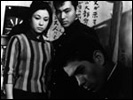A False Student
- Year
- 1960
- Original title
- Nise Daigakusei
- Japanese title
- 偽大学生
- Director
- Cast
- Running time
- 94 minutes
- Published
- 18 January 2008

by Jasper Sharp
Having botched his entrance exams to a prestigious university, the dim-witted but earnest Hikoichi Otsu (Fujio) refuses to swallow his pride by doing the decent thing and admitting his failure to his mother back home in the country. His plight is made more desperate by a recently opened department store in his hometown threatening to engulf the family business and his father's dying words that without a degree one has no future in a rapidly modernising Japan. Not wanting to lose face, he just puts on his uniform anyway and turns up to his literature classes as if he were a bona-fide freshman. He looks sure to get away with his charade too, until a chance encounter with the leader of a group of student radicals named Soratani (Itami) throws him way out of his depth.
Otsu soon pitches himself wholeheartedly into the politicised anti-establishment activities of the student union, though one senses he is swayed in his decision by the presence of the beautiful Mutsuko Takagi (Wakao). Mutsuko's political credentials are impeccable. Her grandfather Jiro Takagi was a famous leftist who was imprisoned and tortured by the military police (kempei-tai) for his anti-government activities during the war, while her uncle is a politics professor at the university. But after a violent altercation with the police, Otsu's sham is exposed. As the police view him as a communist agitator within the university body, and the students suspect him of being a police spy, Otsu suffers at the hands of both sides, but the retribution meted out by his classmates rapidly goes far beyond that of the law.
Though the source material is in fact literary - based on the story Gisho no Toki (trans: Time of Perjury), written by Nobel Prize winner Kenzaburo Oe while the author himself was a student at Tokyo University in 1957 - A False Student's basic set up is a familiar one that stretches right back to some of the early shomingeki produced at Shochiku's Kamata studios, most famously Yasujiro Ozu's I Graduated But... (1929), in which a recent graduate lies to his family in the country about his successful post-university employment. But here the format develops a more cynical twist as befits the 1960s landscape of student rebellion and aggressive mistrust of authority.
The film was released just after the famous Anpo demonstrations against the Japanese government's decision to side with American military might during the Cold War - too soon perhaps to reference it explicitly, although the leftwing student body Zengakuren was already pretty well ensconced within university campuses at this time and proving a thorn in the side of the establishment, and the rise of the New Left would certainly have been a topic at the forefronts of a lot of people's minds. Even if to casual modern-day viewers the context of the film might seem alien, this shouldn't hamper one's comprehension or enjoyment. The political agenda of the students is left deliberately vague and simplistic - in marked contrast to their elders - as the rhetoric of the student leaders evinces little more than a riotous and anarchic distrust of the older generation and the established order that more often recalls the "violence for the sake of violence" satire of Seijun Suzuki's Elegy to Violence and the late-60s works of Koji Wakamatsu penned by Masao Adachi, for example Sex Jack (1970) or Ecstasy of Angels (1971). This is a film of blackly comic excess.
The script is quick to point out that these self-righteous reactionaries, by dint of their privileged education, are to become the country's future leaders. A False Student is ultimately not as much about addressing contemporary political issues as it is a portrayal of how birds of a feather stick together, closing ranks to crush the individual, and to emphasize that politics and decision-making is an environment to which a lowly bumpkin like Otsu clearly does not belong.
Dramatic low angles, well-balanced shot compositions, and ebullient performances stylistically characterise the film as belonging to Yasuzo Masumura, the man behind such modernist masterpieces as Manji (1964) and Red Angel (1966), even if the monochrome photography results in a film that looks a little muted compared with the delirium of his better known works like Blind Beast (1969). But despite a few dramatic missteps in the midsection that rob the powerful material of its full potential, it conjures up the same sense of competitiveness and the chaos of modern life as portrayed in his early classic Giants and Toys (1958).